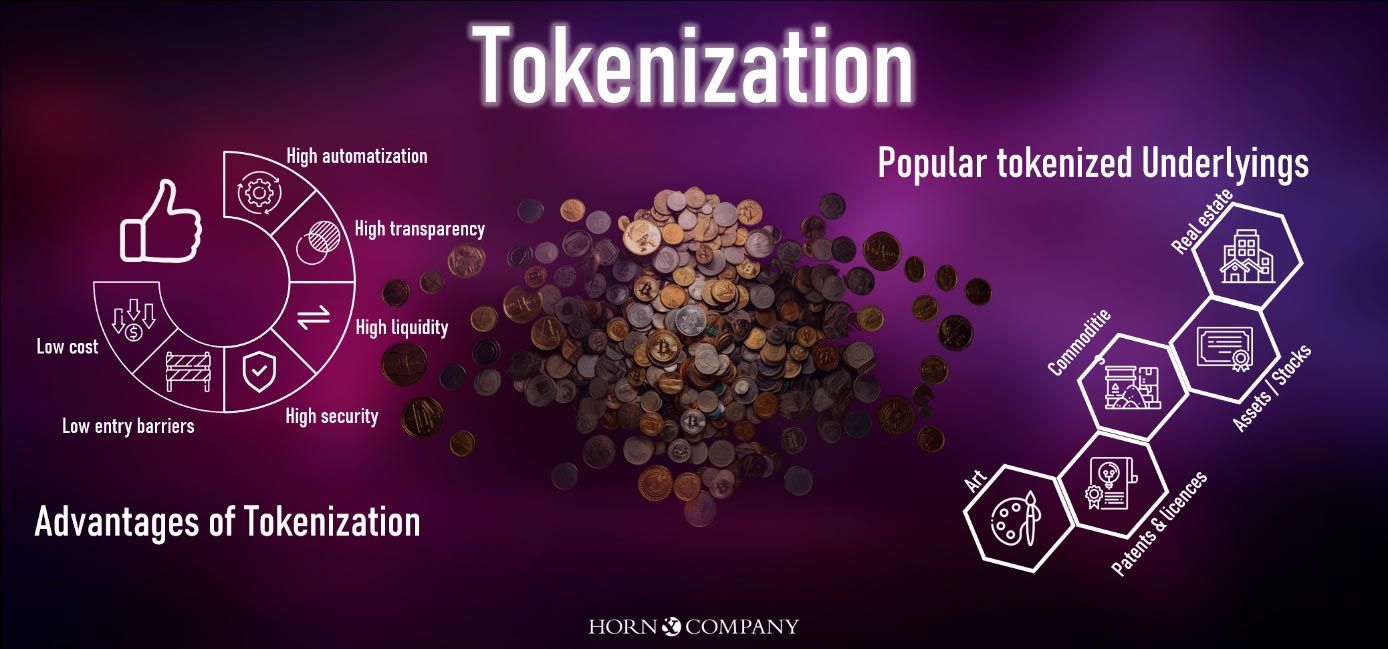
DIGITIZING ASSETS:
HOW TOKENIZATION IS REVOLUTIONIZING THE FINANCIAL WORLD.
#HornAndCompany # Blockspace #DigitalAssets #Token #Crypto
Within the already fast-paced financial world, the tokenization of assets – representing value using blockchain technology – stands as one of the most significant upheavals in recent years. It has the potential to revolutionize traditional financial models and create novel opportunities for investments and asset management. Hence, it’s crucial to keep an eye on this development. In this article, we aim to explore various facets of tokenization and discuss its potential impacts on the financial landscape.
What is tokenization
Tokenization refers to the generation of blockchain tokens that represent tangible assets – such as bonds, securities, precious metals, real estate, artwork, collectibles, copyright licenses, and much more. Each individual token signifies a stake in the ownership of the underlying asset. This allows investors to purchase, sell, or trade these tokens on digital asset marketplaces. At its core, tokenization serves as a bridge between the traditional financial realm and the digital world, harnessing the full benefits of blockchain technology. Particularly, the ability to fractionalize at low marginal costs and the transparent documentation of ownership, combined with inherent tradeability, provides added value compared to traditional securitization solutions.

Types of Tokenizable Assets
With blockchain technology, almost any type of asset can be represented as digital tokens (crypto-assets):
Real Estate: Real estate tokens allow investors to invest in fractions of properties, democratizing access to the real estate market and simplifying diversification. For instance, investors can now participate in tokenized real estate projects that might have previously been out of reach due to high capital requirements.
Company Shares and Stocks: Businesses can tokenize their shares, facilitating trade and drawing in new investors. This can be especially beneficial for startups and SMEs seeking alternative financing solutions. Established issuers, on the other hand, can enjoy quicker settlements. Depending on the underlying and structuring, setting up digital financial products can save around 20%-50% in comparison to traditional vehicles. For a deeper dive into this topic, consider reviewing our publications “Trends in Custody Business” and “Digital Assets“.
Art and Collectibles: Tokenization enables art enthusiasts to purchase shares in artworks without buying the entire piece. This approach makes investing in high-end art pieces accessible, which would otherwise be reserved for affluent collectors. Additionally, blockchain technology introduces entirely new investment products in the realm of digital art. Non-Fungible Tokens (NFTs) are now auctioning pieces for amounts that reach into the millions. (See “NFTs in the Art Business“)
Commodities: Commodities like gold or oil can be tokenized to simplify trade and enhance liquidity. Tokens backed by physical gold serve as a prime example.
Intellectual Property and Licenses: Intellectual property rights, such as patents or copyrights, can also be tokenized, paving the way for new revenue streams for creators and inventors.
Benefits of Tokenization
By digitizing assets in the form of tokens secured on a blockchain, trading processes are streamlined and attract a broader set of investors. This results in increased liquidity, especially significant for assets with a lower trading frequency – such as real estate, art, and other tangible assets. Furthermore, tokenization lowers barriers to market entry, granting more people access to investment opportunities. This not only advances financial inclusion but also allows investors to diversify their portfolios effectively.
Another merit of tokenization is the heightened efficiency and cost savings in transactions. Since blockchain transactions occur directly between parties, intermediaries become redundant. Consequently, tokenized assets secured on a blockchain are typically faster and more cost-effective than traditional methods.
Simplified asset management and the potential for programmable assets are two more pivotal benefits of tokenization. Tokenization can streamline asset management processes, lessen administrative burdens, and provide real-time insights into asset performance. Additionally, smart contracts, representing programmable assets, facilitate the automation and enforcement of specific terms and conditions, such as dividend distributions or voting rights, simplifying asset management further.
Lastly, the underlying blockchain technology in tokenization offers unparalleled transparency and security. Transactions are visible to all blockchain participants, and the blockchain’s immutability ensures data remains tamper-proof. This fosters a sense of trust and reliability, invaluable to investors.
Legal Aspects and Challenges
Tokenization currently often operates in a legal gray area, as regulatory frameworks in many countries are not yet fully defined. Here are some of the legal aspects and challenges:
Token Classification: One of the most significant challenges is determining the legal classification of tokens. In some instances, they may be viewed as securities, subjecting them to securities regulations. In others, new definitions and legal frameworks need to be created to accommodate the requirements and possibilities of tokenization. (Refer to our post on MiCA regulation)
Investor Protection: Safeguarding the rights and interests of investors is a primary concern. Mechanisms need to be in place to ensure that investors are protected from fraud and market manipulation.
Anti-Money Laundering (AML) and Know Your Customer (KYC): Tokenization platforms must implement AML and KYC procedures to verify the identity of investors and prevent illegal activities like money laundering.
Data Protection: The benefits of blockchain technology in ensuring the transparency of transactions involving tokenized assets also raise questions about investor data protection, which need to be addressed by lawmakers.
Cross-border Transactions: Tokenization enables cross-border transactions, leading to potential conflicts between the legal provisions of different countries. For instance, in Germany, the regulation of tokenized assets is relatively advanced. Laws like the eWPG and the Cryptocurrency Regulation provide clear guidelines and a regulatory environment where institutions can operate with legal certainty. In contrast, other countries either have no regulation or a much vaguer one regarding tokenized assets. Harmonization in this regard might only gradually occur over the coming years.
Conclusion: evolution in the financial industry
Tokenization of assets is an emerging phenomenon with the potential to fundamentally reshape the financial industry. By converting physical assets into digital tokens, it opens up novel avenues for investments, liquidity, and global trade relationships. While the benefits are immense, the legal challenges cannot be overlooked. It’s crucial that the industry and regulatory bodies collaborate closely to create an environment that encourages innovation while simultaneously safeguarding the security and interests of investors. Without a doubt, tokenization is a stride towards a more efficient and inclusive financial world.
In our next blog post, we will delve deeper into the future prospects of tokenization, examining how it might evolve and its potential impacts on various industries. Stay tuned!
DO YOU HAVE SPECIFIC QUESTIONS ABOUT TOKENIZATION?
Our experts at Horn & Company are available to personally discuss your potential use cases regarding tokenization. Contact us today to learn about your opportunities in the realm of digital assets.


